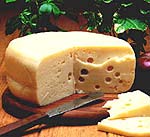 Gassy bacteria are behind all Swiss holed cheese. In order to make cheese, you need the help of bacteria. Starter cultures containing bacteria are added to milk, where they create lactic acid, essential for producing cheese. Various types of bacteria can be used to make cheese, and some cheeses require several different bacteria to give them a particularflavor. Gassy bacteria are behind all Swiss holed cheese. In order to make cheese, you need the help of bacteria. Starter cultures containing bacteria are added to milk, where they create lactic acid, essential for producing cheese. Various types of bacteria can be used to make cheese, and some cheeses require several different bacteria to give them a particularflavor.
Propionibacter shermani is one of the three types of bacteria used to make Swiss cheese, and it's responsible for the cheese's distinctive holes. Once P. shermani is added to the cheese mixture and warmed, bubbles of carbon dioxide form. These bubbles become holes in the final product. Cheesemakers can control the size of the holes by changing the acidity, temperature, and curing time of the mixture. Incidentally, those holes are technically called "eyes," and the proper Swiss name for the cheese is Emmentaler (also spelled Emmental or Emmenthaler).
 Swiss cheese has been in the news recently because the U.S. Department of Agriculture (USDA) created new guidelines that regulate the hole size of domestically produced Swiss cheese. The USDA reduced the standard size of the holes by half because new cheese-slicing machinery got caught on larger holes. The Swiss weren't pleased by the revised guidelines and insist that Emmentaler must have large holes. Considering how iconic those eyes are, we think they have a good point. Swiss cheese has been in the news recently because the U.S. Department of Agriculture (USDA) created new guidelines that regulate the hole size of domestically produced Swiss cheese. The USDA reduced the standard size of the holes by half because new cheese-slicing machinery got caught on larger holes. The Swiss weren't pleased by the revised guidelines and insist that Emmentaler must have large holes. Considering how iconic those eyes are, we think they have a good point.
|
flavor: 口味 |
